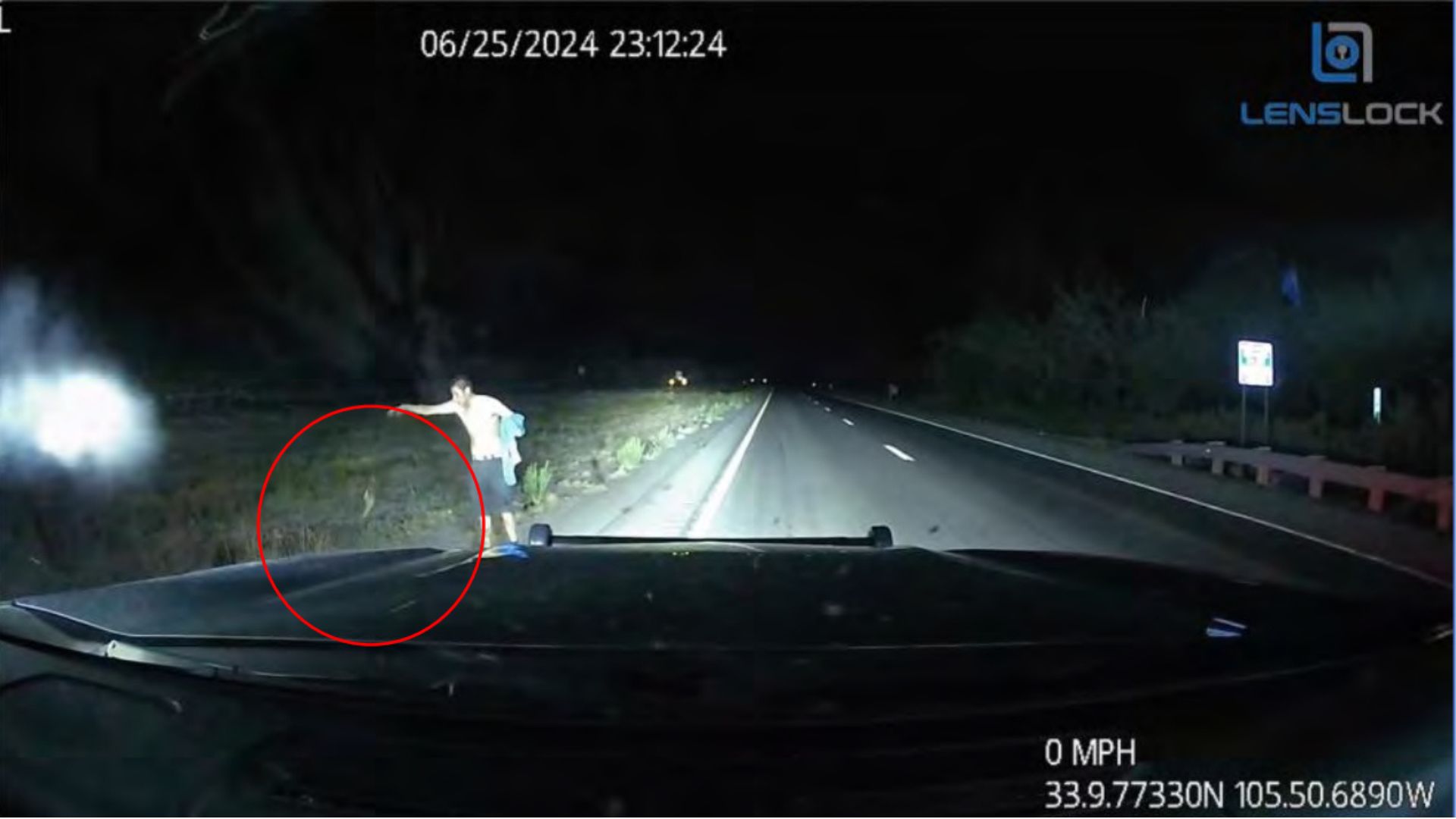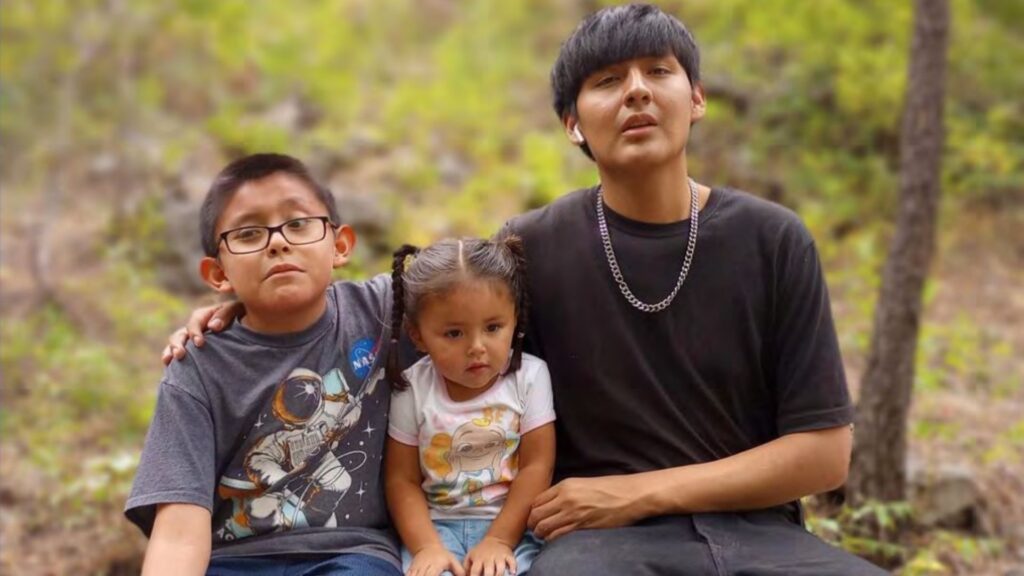When a call for help ends in gunfire
A new lawsuit in the 2024 fatal police shooting of teenager Elijah Hadley could shed light on a persistent problem in New Mexico: an outsized portion of police violence begins with a welfare check
This story was originally published at Searchlight New Mexico, a NMPBS partner.

By Joshua Bowling, Searchlight New Mexico
It was a few minutes before 11 p.m. on a warm June night when a driver called 911 from U.S. Route 70, the long stretch of highway that connects Las Cruces to Alamogordo and White Sands National Park. The driver spotted someone walking along the median; a deputy with the Otero County Sheriff’s Office took the call.
In about 30 minutes, Deputy Jacob Diaz-Austin arrived in his patrol car. Elijah Hadley, a 17-year-old boy who was a registered member of the Mescalero Apache Tribe, waved a shirt in greeting and kept walking in the median, toward the deputy’s vehicle. Diaz-Austin told Hadley to stop, and he did, holding his right hand over his eyes to shield them from the deputy’s harsh lights.
“Let me see your other hand, bro,” Diaz-Austin called out to Hadley. “Let me see your other hand, dog.”
Hadley extended his other arm, which loosely held a BB gun that was styled like a pistol and pointed it at the ground. When Diaz-Austin told him to drop it, Hadley promptly threw it into thick brush in the median. That was when Diaz-Austin pulled his trigger four times, according to a new lawsuit filed by Hadley’s family. Hadley fell onto the road, screaming. As his blood spilled onto the hot blacktop, he called out “It’s just a BB gun” and “I’m dying.” The deputy continued to demand that the boy show his hands. Despite the pain, Hadley continued to comply.
After three-and-a-half minutes passed, the lawsuit says, Diaz-Austin opened fire again, this time shooting Hadley 14 times. As Hadley’s now-limp body sat on the highway, the suit says, Diaz-Austin reloaded his service weapon and fired another four shots into the boy’s back. All told, he shot him 22 times.
Later, when a sergeant with the Otero County Sheriff’s Office reviewed the shooting, he decided that Diaz-Austin had “complied with the county’s policies and training,” the lawsuit says. Nonetheless, Diaz-Austin was charged with first-degree murder in January. The civil suit brought in June by Hadley’s family seeks compensation for physical and emotional pain and suffering and the “value of Hadley’s life apart from his earnings.” The family’s attorneys filed the suit in federal court and are seeking an unspecified amount of punitive damages.
Hadley’s death “highlights the contrast between the public, who believe that calling the police is a way to keep people safe, and this sheriff’s office, who endangers the public,” Tyson Logan, the family’s attorney, told Searchlight. “This motorist had no idea that calling the police might get this teenager shot to death.”

When a welfare check turns deadly
Hadley’s story is like that of many across New Mexico and the nation. Time and again, “welfare checks” — non-violent 911 calls that ask a first responder to check in on someone’s mental health, safety or general wellbeing — end with a fatal display of violence. After such shootings, municipalities often turn to alternative response models and internal reviews of police shootings, yet the trend persists.
Nationally, police in New Mexico routinely kill civilians at an outsized rate, according to the nonprofit Mapping Police Violence, which tracks data nationwide. In 2023, Searchlight reported that the Albuquerque Police Department, in particular, contributed heavily to this trend. In 2022, Searchlight found, Albuquerque police killed 10 people in shootings — a total surpassed only by police forces in Los Angeles, New York and Houston, all of which dwarf Albuquerque in size.
As happened with Hadley, many of these cases start with a call for help. In Las Cruces in 2022, police shot and killed Amelia Baca, a 75-year-old grandmother with dementia who spoke no English, after her family called 911 and asked for help, because they believed she appeared to be off her medication. She came to the door holding a kitchen knife in each hand and looked confused when an officer shouted at her, in English, to “drop the fucking knife.” In Albuquerque that same year, police shot and killed Collin Neztsosie — from long distance with assault rifles — on Central Avenue while he was on the phone with a 911 dispatcher and was visibly suffering a mental health crisis.
Municipal officials have often used such cases as proof of the need for alternative response models. Shortly after George Floyd’s murder in 2020, Albuquerque police shot a young man suffering a “schizoaffective episode,” as his family called it, during a mental health call in which he asked officers to kill him. Within weeks, city leaders announced the creation of Albuquerque Community Safety, a stand-alone public safety department consisting of licensed clinical social workers and behavioral health professionals who would respond to nonviolent 911 calls, including mental health crises, homelessness and overdoses.
Five years later, though, police officers continue to kill civilians even after mental health professionals were called to the scene.
In February, Albuquerque police sent armed officers to the apartment of 67-year-old David McElvain and killed him after he allegedly pointed a gun at the officers. Earlier that day, ACS responders knocked on McElvain’s door because a colleague had called 911 and expressed concern that McElvain was going to harm himself. Police officials at the time said that McElvain, who “wanted to hurt himself,” refused to meet with the mental health responders but opened the door for the responding officers before pointing a gun at them.
It’s not an uncommon story: Someone calls 911 when a friend or family member is experiencing a mental health crisis, unarmed behavioral health professionals initially respond, and by day’s end, news of a fatal police shooting hits the news. The problem is so acute that one of ACS’ much-publicized hires, Elaine Maestas, has since accused the department of undercutting its own mission to remedy the city’s problem with police violence.
When Maestas was hired by ACS in 2022, she was already well-known in the Albuquerque area for her activism following the death of her sister, Elisha Lucero, who Bernalillo County sheriff’s deputies had shot 21 times in the midst of a mental health crisis. Lucero was living in an RV outside her uncle’s South Valley home and was experiencing symptoms of psychosis after undergoing surgery to remove a brain tumor. One night, she slapped her uncle in an argument — so her family called 911, remembering that first responders had previously taken her to the hospital in similar situations. When two deputies arrived, Lucero allegedly rushed at them with a kitchen knife, and they shot her “until she was no longer a recognizable person,” Maestas told me in an interview in 2023. This March, Maestas filed a lawsuit against the city and alleged that “below the surface, ACS is not what it purports to be.”
“In fact, ACS operates hand-in-glove with the Albuquerque Police Department, often relying on APD for the types of calls that ACS tells the public it handles on its own,” the lawsuit says. Maestas alleges that she witnessed an ACS responder joking with an APD officer about “roughing up” a civilian.
A young, relatively untested law
For five years now, reform advocates have looked to alternative response programs like ACS to bring about change. More recently, survivors of shootings and family members of victims have turned to a new law.
Hadley’s family is invoking the New Mexico Civil Rights Act, which was passed in 2021. The law did away with qualified immunity as a defense for New Mexico government officials. Their lawsuit claims that the sheriff’s deputy who killed Hadley and the elected members of the Otero County Commission violated his civil rights — namely, the right to life and liberty — by allowing Diaz-Austin, the sheriff’s deputy, to use “objectively unreasonable lethal force.”
The state law is still so young, though, that its parameters are not fully known. Many of the cases that could test its contours, including one brought in May by Jacob Johns, the survivor of the 2023 shooting at an anti-Oñate rally in Española, have yet to go to trial.
“We view the constitutional rights as quite straightforward here,” Logan, the attorney for Hadley’s family, said. “Really, there’s no question that shooting an unarmed teenager 22 times violates both the U.S. Constitution and the New Mexico Constitution.”
This story was originally published at Searchlight New Mexico, a NMPBS partner.

